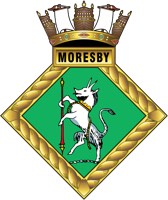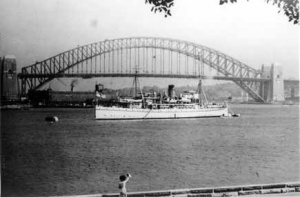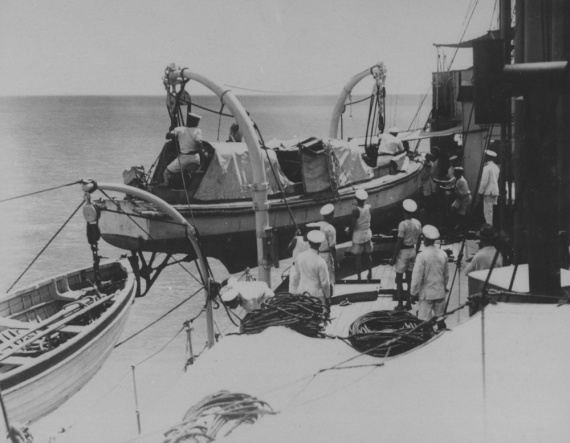HMAS Moresby (I)
| Class |
24 Class |
|---|---|
| Type |
Survey Sloop |
| Builder |
Barclay Curle and Co Ltd, Glasgow, Scotland |
| Laid Down |
27 November 1917 |
| Launched |
12 April 1918 |
| Commissioned |
20 June 1925 |
| Decommissioned |
14 March 1946 |
| Dimensions & Displacement | |
| Displacement |
|
| Length | 276 feet 6 inches |
| Beam | 34 feet 10 inches |
| Draught | 16 feet 7 inches |
| Performance | |
| Speed | 14 knots |
| Armament | |
| Guns |
|
| Other Armament | 2 x Oerlikons (wartime) |
| Awards | |
| Battle Honours | |

HMAS Moresby was built as one of the 24 Class of Royal Navy (RN) mine-sweeping sloops. She originally commissioned in the RN as HMS Silvio on 25 May 1918. The 24 Class of ships is sometimes referred to as the 'Racehorse' Class due to the vessels in the class being named after English Derby winners.
HMS Silvio saw brief service during World War I performing convoy escort duties. After the war she was paid off and laid up before being refitted at Pembroke Dockyard, South Wales, as a surveying vessel in 1924-25. She was subsequently transferred to the Royal Australian Navy and commissioned as HMAS Moresby on 20 June 1925 under the command of Captain John A Edgell OBE, RN, who later rose to the rank of Vice Admiral, becoming the Hydrographer to the Admiralty.
Moresby was named in honour of Admiral John Moresby, who discovered Port Moresby and Fairfax Harbour on 21 February 1873 naming them after his father, Admiral of the Fleet Sir Fairfax Moresby, GCB.
Moresby sailed from England for Australia on 28 June 1925. En route she visited Gibraltar, Port Said, Aden, Colombo Singapore, and Thursday Island before arriving in Brisbane on 10 September 1925.
She was soon actively engaged conducting survey duties on the Great Barrier Reef until, for reasons of economy, she paid off into reserve at Sydney on 21 December 1929.
Moresby recommissioned on 27 April 1933 to undertake urgent strategic survey work in northern Australia. Throughout 1933 and 1934 she operated variously in survey grounds off Queensland and along the northern coast of Australia visiting Bowen, Townsville, Brisbane, Melville Island and Darwin on numerous occasions. Later she conducted port visits to Fremantle, Goode Island and Sydney where she again paid off into reserve on 14 December 1934. While in reserve Moresby's machinery was converted to burn oil.
On 11 April 1935 Moresby recommissioned and she was soon undertaking valuable survey work in the vicinity of Cliffy Island to the east of Wilsons Promontory. In June 1935 she proceeded to Darwin from where she conducted a series of hydrographic surveys in the area until 28 October 1935. She then proceeded to northern Queensland survey grounds. In May 1937 the eruption of volcanoes at Vulcan Island and Matupi, near Rabaul, caused the evacuation of the town's inhabitants to Kokopo as a safety precaution. Moresby, then in the Gulf of Carpentaria, was ordered to proceed to Rabaul and render assistance. It transpired that she was required only to supply badly needed provisions.
This pattern of survey work in northern waters, including those surrounding New Guinea, continued up until the outbreak of World War II in September 1939. Although often monotonous in nature, Moresby's survey work was to later prove vital to operations in the New Guinea theatre of operations.
For the first year of the war Moresby served as an anti-submarine training vessel operating on Australia's the eastern seaboard. In January 1941 she resumed her former duty as a survey ship and until the outbreak of war with Japan in December 1941 was engaged in survey operations in northern Australian and New Guinea waters.
Throughout 1942 and 1943 Moresby undertook convoy escort and anti-submarine duties in eastern Australian waters and was almost constantly at sea during that time. On 11 April 1943 while escorting convoy O.C.86 to Newcastle a Japanese submarine torpedoed the Yugoslav ship Recina which sank in less than a minute. Moresby carried out an immediate counter attack dropping seven depth charges but with no visible result. Ten survivors were subsequently recovered before the search was abandoned due to inclement weather. Japanese submarines were active during Moresby's time as an escort claiming nineteen ships with the loss of 568 lives.
In November 1943 Moresby ceased escort duties and prepared to resume service as a survey vessel. From December 1943 until the end of the war she was engaged on survey operations mainly in the Darwin and Bathurst Island areas.
At 11:00 on 7 September 1945, Moresby, under the command of Lieutenant Commander D' AT Gale, DSC, RAN, left Darwin in support of Operation TOFO, the surrender for all Japanese Forces in Timor. Embarked in Moresby were the Senior Naval Officer of the operation Commander GL Cant, RAN, and Brigadier LGH Dyke, CBE, DSO, who had been appointed to accept the surrender of the Japanese forces in Timor or controlled from Timor. Sailing in company with Moresby were HMA Ships Horsham, Benalla, Echuca, Parkes, Katoomba, Kangaroo, Bombo and the Harbour Defence Motor Launches (HDML) 1322, 1324 and 1329. Also in the convoy were the Dutch minesweeper Abraham Crijnssen and the transport Van den Bosch.
En route to Timor the convoy was joined by the corvettes HMAS Warrnambool and Gladstone increasing the RAN presence. At 08:00 on 11 September the convoy arrived at the appointed rendezvous off Koepang and two Japanese officers boarded Moresby for interrogation regarding the location of minefields and underwater obstructions. On completion of the interrogation the convoy entered harbour in column with Abraham Crijnssen sweeping ahead of the line of ships all of which were closed up at action stations. At 10:30 Moresby anchored off Koepang with the other ships anchoring nearby. At 11:50 the Japanese army and navy commanders boarded Moresby and were escorted to the quarterdeck where the stage was set for the surrender ceremony.
Assembled on Moresby's quarterdeck were the commanding officers of the ships of the convoy, army staff officers, Moresby's officers and press correspondents. At noon the Japanese army commander, Colonel Kaida, signed the instrument of surrender of all Japanese forces in Timor, a total of 3235 men, and this was accepted by Brigadier Dyke. Two days later Moresby sailed for Darwin to resume survey operations. On 24 September, however, she was recalled to Timor to assume the role of senior RAN ship in the area, remaining there as Headquarters Ship for Brigadier Dyke until 4 October 1945 at which time she returned to Darwin.
In November 1945 Moresby carried out a final survey of Yampi Sound, Western Australia, before returning to Sydney where she arrived on 13 December 1945.
Moresby paid off on 14 March 1946 and on 3 February 1947 she was sold for breaking up to Broken Hill Pty Co Ltd. She was subsequently scrapped at Newcastle, NSW.









